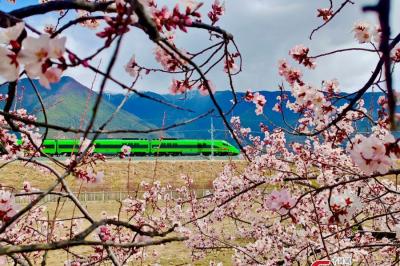|
"Devoted to the study of Tibetan Buddhism, the most important thing in our lives, we must also take on chores as necessary such as fetching water and cleaning," said Ngawang Paljor.
The next day, he is tasked with something unrelated to Buddhist study -- the abbot has asked him to build a fence around the field in front of the temple to prevent livestock belonging to local herdsmen from trampling the grass.
He removes his crimson robe and puts on the ordinary trousers and shirt of any worker. Woolly hat protecting his shaven head, only the red down jacket that protects him from the relentless wind distinguishes him as a monk.
In a tent beside the field, Ngawang Dorje, 38, sells souvenirs to tourists. He came to Rongpo Monastery 15 years ago, the same year as Ngawang Paljor.
Ngawang Dorje chose not to become a monk. It is a lifestyle suited only to a very few. He makes his living by carving and selling "mani stones." These are just ordinary pieces of local stone carved with the six symbols of the mantra, "Om mani padme hum." The carving on the stones is seen as a highly devotional act, similar in nature to more recognizably doctrinal activities within the walls of the monastery.
CALL OF THE SOUL
Although Tenzing Norgay and Sir Edmund Hillary became the first men to reach the summit of Mount Qomolangma only 64 years ago, Tibetan monks have been striving to reach the peak of enlightenment for over 1,000 years.
Located on the north slope of the mountain, near the current base camp where aspiring climbers prepare for their ascent, Rongpo dates back only 100 years. "But the area has witnessed the spread of Buddhism in Tibet for many centuries," said Ngawang Paljor.
He mentions a local legend often told to tourists that the monastery was a place of retreat for Padmasambhava, also known as Guru Rinpoche, an eighth-century Indian Buddhist master. He heard the story countless times from his grandmother when he was a young boy, and it sparked his interest in Buddhism.
"At Tibetan Buddhist festivals or other important occasions, my grandma would fill a bowl with water before the Buddha shrine and pray for world peace and the health of our livestock," he recalled. |
- Home
- News |Tibet |Exclusive |China |World |Related News |Latest
- Documents |White Papers |Others
- Photo |Politics |Economy & Society |Culture & Religion |Human & Nature |Beautiful Tibet |Other Tibetan-Inhabited Area |Exchanges |Related
- Video |News |Documentary |Micro-Video |Entertainment
- Art
- Tourism
- In Focus
- About Tibet






